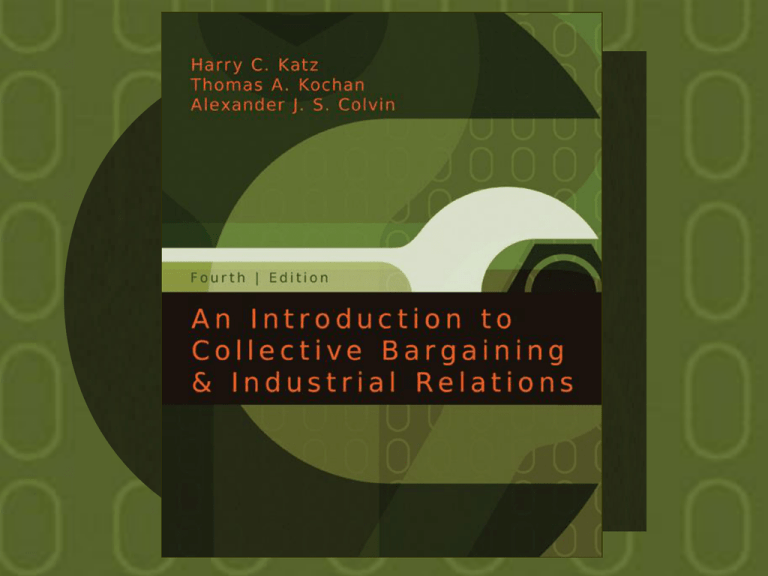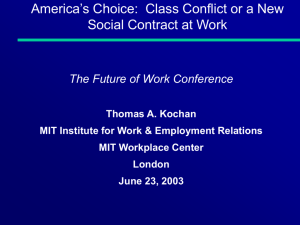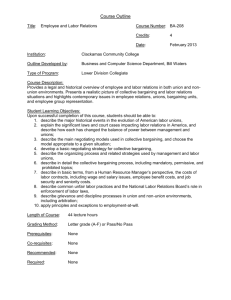
Chapter
3
The Legal Regulation of
Unions and Collective
Bargaining
McGraw-Hill/Irwin
An Introduction to Collective Bargaining & Industrial Relations, 4e
Copyright © 2008 The McGraw-Hill Companies, Inc. All rights reserved.
3 -3 1 - 3
The Conspiracy Doctrine
• From 1800 to 1890 state courts relied on British
common law to regulate the conduct of unions and
employers
• Cordwainers’ case: First landmark case in 1806
- Court ruled efforts to raise wages were a criminal
conspiracy
• Commonwealth v. Hunt: In 1842, court ruled unions
could exist, but were prohibited from using coercive
practices
3 -4 1 - 4
The Sherman Antitrust Act
• Courts applied Sherman to unions, treating
them as a “commodity”
• Unions were treated like other monopolies or
conspiracies that restricted trade
• Courts used injunctions to discourage strikes
• Employers could gain injunctions quickly
3 -5 1 - 5
The Clayton Act
• Unions lobbied hard to end injunctions
• In 1914, Congress passed the Clayton Act
• The act was supposed to end the use of injunctions,
but courts interpreted it narrowly and state courts
continued to use injunctions
3 -6 1 - 6
Legislation Granting Rights to Collective
Bargaining
• Legal and public policy opposition to the formation of
unions began to erode in the early 20th century
- Lloyd-LaFollette Act of 1912 gave postal employees
the right to organize
- War Labor Board supported rights for the private
sector to organize
- The start of pragmatic adjustments in response to
union power and labor turmoil
3 -7 1 - 7
The Railway Labor Act
• Passed by Congress in 1926
- Specifies that the employees have the right to organize
unions without employer interference and to bargain
through the representatives of their own choosing
- The purpose of the law was to establish procedures to
reduce conflict in the railroads
- Airlines were added in 1936
3 -8 1 - 8
A Test of Constitutionality
• The constitutionality of the RLA was in
question until a Supreme Court Ruling
- In 1930, Court heard Texas and New Orleans
Railroad Company v. Brotherhood of Railway and
Steamship Clerks
- Court ruled that bargaining was in the “highest
public interest” and would prevent the interruption
of commerce
- First time Supreme Court recognized the authority
of the U.S. to protect union activities
3 -9 1 - 9
The Norris LaGuardia Act
• Passed in 1932, the Act provided an even stronger
endorsement of collective bargaining than the RLA
- It allows private sector employees full freedom of
association, self-organization, and representatives to
negotiate contractual terms
- Also known as the “Federal Anti-Injunction Act” as it
imposed restraints (but state courts continued to issue
injunctions)
1 - 10
3 -10
National Industrial Recovery Act
• NIRA passed in 1933 to promote recovery from the
Depression
- Allowed business groups to plan & regulate prices;
workers in the plan had minimum wages
- Meant to stimulate business activity
- Struck down by Supreme Court; Congress had
exceeded its authority
- From 1933-1935, union members grew from 2.9 to
3.9 million
1 - 11
3 -11
National Labor Relations Act
• Passed in 1935, the NLRA made union activity and
strikes legal in the private sector
- Purpose was to promote orderly and peaceful
recognition of unions and collective bargaining as a
means of establishing terms of employment
- Later amended by Taft-Hartley (1947) and LandrumGriffin (1959)
1 - 12
3 -12
National Emergency Disputes
• Title II of the NLRA includes procedures when a
strike has caused a national emergency dispute
- The NLRA created the Federal Mediation and
Conciliation Service (FMCS) to mediate
disputes and assist in the free flow of commerce
- President can ask for a court injunction to
require both sides to work under the expired
contract while holding negotiations
- If that fails, Congress can end the dispute
1 - 13
3 -13
Administration of the NLRA
• A five-member board with a general counsel, 50
regional boards and staff administers the NLRA
- Key function of the NLRB is to supervise and conduct
representation elections and to adjudicate charges of
unfair labor practices
- The NLRB can award back pay but cannot assess
punitive damages
- Court must enforce orders and the aggrieved can
appeal to court
1 - 14
3 -14
The Taft-Hartley Act
• After WWII, labor unions had grown in strength and a
strike wave stimulated hostility toward unions
• Congress passed the Taft-Hartley in 1947 to balance
the power and grant more individual rights in dealing
with unions
- Union unfair practices were added to Section 8
• Excludes supervisors in the private sector from
coverage under the NLRA
• Mandates labor reports to DOL, frequency of union
elections, and allows DOL trusteeship
1 - 15
3 -15
The Landrum-Griffin Act
• Known also as the Labor-Management Reporting and
Disclosure Act of 1959
- Major purpose was to protect union members from
improper union conduct
- Eliminated arrangements between unions and
employers that deprive members of proper union
representation
- Includes “bill of rights” section for members
1 - 16
3 -16
The Value of Collective Bargaining
• The Contribution to Political Democracy
- Right to form unions and carry out strikes is an
essential component of political democracy
• The Need for the Right to Strike
- Since the freedom to enter a contract also requires the
freedom to reject a contract offer, the right to negotiate
and strike are closely related
1 - 17
3 -17
Public Sector Law
• Collective bargaining rights were granted to federal
employees through Executive Order 10988 in 1962
- The Civil Service Reform Act of 1978 established the
FLRA for the federal sector
• Since the passage of the NLRA, 41 states have passed
collective bargaining legislation for state and local
employees
1 - 18
3 -18
Employment at Will
• Doctrine that stipulates that the employee and
employer are free to end the employment relationship
at any time, for any reason, and without liability,
provided the termination does not violate any
statutory or constitutional provisions
• Thus, non-union employees may have no recourse if
discharged
1 - 19
3 -19
The Scope of the Doctrine
• State courts have decided for the employment-at-will
doctrine:
- When there is no written contract, no specified term of
employment, and no employee handbook
- When an employee handbook is insufficient to establish
exceptions to the “at will” doctrine
• An expired union contract leads to employment at will
- Otherwise, the contract would discourage good faith
bargaining and be “inimical” to the collective
bargaining process
1 - 20
3 -20
Exceptions Imposed by State Courts
• State courts have awarded back pay and reinstatement
to discharged employees when:
- The employer’s written policies constitute an implied
contract and employment security
• This limits employer discharge to “just cause”
- Promises of employment security in a oral or written
agreement, or through actions that lead employees to
expect employment security
- Firing an employee for refusing to violate statutory
policy
1 - 21
3 -21
Employment Standards Law
• Society has regulated certain employment conditions
more directly than it does collective bargaining
- In the U.S., such regulations include workers
compensation, social security, fair labor standards,
safety, pensions, and other issues
- Compared to other countries, the U.S. has
relatively little direct regulation of employment
conditions
1 - 22
3 -22
Employment Discrimination Law
• The key statute is Title VII of the Civil Rights Act
- It prohibits discrimination in employment on the grounds of
"race, color, religion, sex, or national origin"
• Two types of employment discrimination prohibited by Title
VII
- Disparate Treatment
- Disparate Impact
• Age Discrimination in Employment Act (ADEA)
- Prohibits discrimination against workers over the age of 40
• Pregnancy Discrimination Act
- Amended Title VII to define pregnancy discrimination as sex
discrimination
1 - 23
3 -23
Filing Employment Discrimination
Complaints
• To begin a federal complaint, the employee must file a
complaint with the EEOC
- The EEOC will investigate and, if merited, seed a
resolution
- EEOC will then issue a "right to sue" letter, indicating
that the required administrative process has been
completed
• In a small number of important cases, the EEOC will
file suit in court against the employer on behalf of the
employee
- This occurs in 1-2 percent of all cases
1 - 24
3 -24
Growth of Employment Litigation
• Employment litigation has increased in recent years
- Sometimes resulting in large and unpredictable
damage awards
- Litigation increased since the 1960s with the passage
of employment discrimination and employment
standards statues
- Federal court lawsuits rose from 8,937 cases in 1987
to 22,553 cases in 2000.
- From 1994 – 2000, the median (typical) award was
$110,000 and the mean (average) was $301,000.
1 - 25
3 -25
Seniority and Equal Employment
Opportunity Policy Goals
• Seniority provisions regulate which worker will be
laid off and who is eligible for promotion
- In the past, some seniority systems were used to
discriminate against minorities and women by
creating segregated seniority units or
progression ladders
• Policy goals of courts are to:
- Ensure practices do not discriminate
- Avoid perpetuating past discrimination
- Protect the interests of non-minorities who are
not responsible for past discrimination
1 - 26
3 -26
Key Court Decisions on Seniority Systems
• Supreme Court ruled in 1977 that departmental
seniority units are legal as long as there is no intent
to discriminate
• Consent decrees are separate from judicial rulings
- Federal agencies negotiate settlements, such as
in the steel industry
- Cannot be binding on persons who are not
parties to the proceedings
• Seniority systems cannot be altered by a court to
benefit workers not victims of discrimination
1 - 27
3 -27
Key Court Decisions on Affirmative
Action
• The term “affirmative action” was first introduced by
JFK in 1961 by Executive Order 10925
• Title VII does not require affirmative action, but does
require nondiscrimination in hiring, pay, and
promotion
• In the 1960s and 1970s, the Supreme Court expanded
legal avenues for women and minorities battling
discrimination
• A more conservative shift began in the late 1970s
1 - 28
3 -28
Important Administrative Agencies
• National Labor Relations Board (NLRB)
- Administers the NLRA, including Taft-Hartley and
Landrum-Griffin amendments
• Key activities include designating bargaining units,
conducting representation elections, and
investigating and adjudicating unfair labor practice
charges
• U.S. Department of Labor
- Conducts research and collects data
- Also oversees equal opportunity employment,
health and safety, and internal union affairs
1 - 29
3 -29
Important Administrative Agencies
(continued)
• Federal Mediation and Conciliation Service (FMCS)
- Offers mediation service to labor and management in
collective bargaining
• National Mediation Board
- Administers the Railway Labor Act, union representation,
and mediation services
• State and Local Agencies
- A variety of agencies that regulate the conduct of public
sector bargaining, provide mediation, and administer
regulations
• Equal Employment Opportunity Commission (EEOC)
- Employment discrimination claims
1 - 30
3 -30
Summary
• Labor laws influence the conduct of collective
bargaining
• The NLRA is the key labor law that governs
collective bargaining
- Passed in 1935, it gives unions the right to strike,
exclusive jurisdiction, defines unfair labor practices,
and regulates bargaining
- Before the NLRA, courts had applied the conspiracy
doctrines and injunctions
• Separate state laws for public sector bargaining

![Labor Management Relations [Opens in New Window]](http://s3.studylib.net/store/data/006750373_1-d299a6861c58d67d0e98709a44e4f857-300x300.png)


